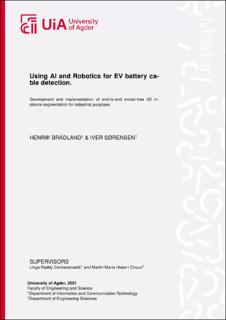| dc.contributor.author | BRÅDLAND, HENRIK | |
| dc.contributor.author | SØRENSEN, IVER | |
| dc.date.accessioned | 2021-10-19T12:32:46Z | |
| dc.date.available | 2021-10-19T12:32:46Z | |
| dc.date.issued | 2021 | |
| dc.identifier.citation | Brådland, H. & Sørensen, I. (2021) Using AI and Robotics for EV battery cable detection.: Development and implementation of end-to-end model-free 3D instance segmentation for industrial purposes (Master's thesis). University of Agder, Grimstad. | en_US |
| dc.identifier.uri | https://hdl.handle.net/11250/2823906 | |
| dc.description | Master's thesis in Information- and communication technology (IKT590) | en_US |
| dc.description.abstract | This thesis describes a novel method for capturing point clouds and segmenting instances of cabling found on electric vehicle battery packs. The use of cutting-edge perception algorithm architectures, such as graph-based and voxel-based convolution, in industrial autonomous lithium-ion battery pack disassembly is being investigated. The thesis focuses on the challenge of getting a desirable representation of any battery pack using an ABB robot in conjunction with a high-end structured light camera, with "end-to-end" and "model-free" as design constraints. The thesis employs self-captured datasets comprised of several battery packs that have been captured and labeled. Following that, the datasets are used to create a perception system. This thesis recommends using HDR functionality in an industrial application to capture the full dynamic range of the battery packs. To adequately depict 3D features, a three-point-of-view capture sequence is deemed necessary. A general capture process for an entire battery pack is also presented, but a next-best-scan algorithm is likely required to ensure a "close to complete" representation. Graph-based deep-learning algorithms have been shown to be capable of being scaled up to50,000inputs while still exhibiting strong performance in terms of accuracy and processing time. The results show that an instance segmenting system can be implemented in less than two seconds. Using off-the-shelf hardware, demonstrate that a 3D perception system is industrially viable and competitive with a 2D perception system. | en_US |
| dc.language.iso | eng | en_US |
| dc.publisher | University of Agder | en_US |
| dc.rights | Attribution-NonCommercial-NoDerivatives 4.0 Internasjonal | * |
| dc.rights.uri | http://creativecommons.org/licenses/by-nc-nd/4.0/deed.no | * |
| dc.subject | IKT590 | en_US |
| dc.title | Using AI and Robotics for EV battery cable detection.: Development and implementation of end-to-end model-free 3D instance segmentation for industrial purposes | en_US |
| dc.type | Master thesis | en_US |
| dc.rights.holder | © 2021 HENRIK BRÅDLAND, IVER SØRENSEN | en_US |
| dc.subject.nsi | VDP::Teknologi: 500::Informasjons- og kommunikasjonsteknologi: 550::Teknisk kybernetikk: 553 | en_US |
| dc.source.pagenumber | 117 | en_US |

